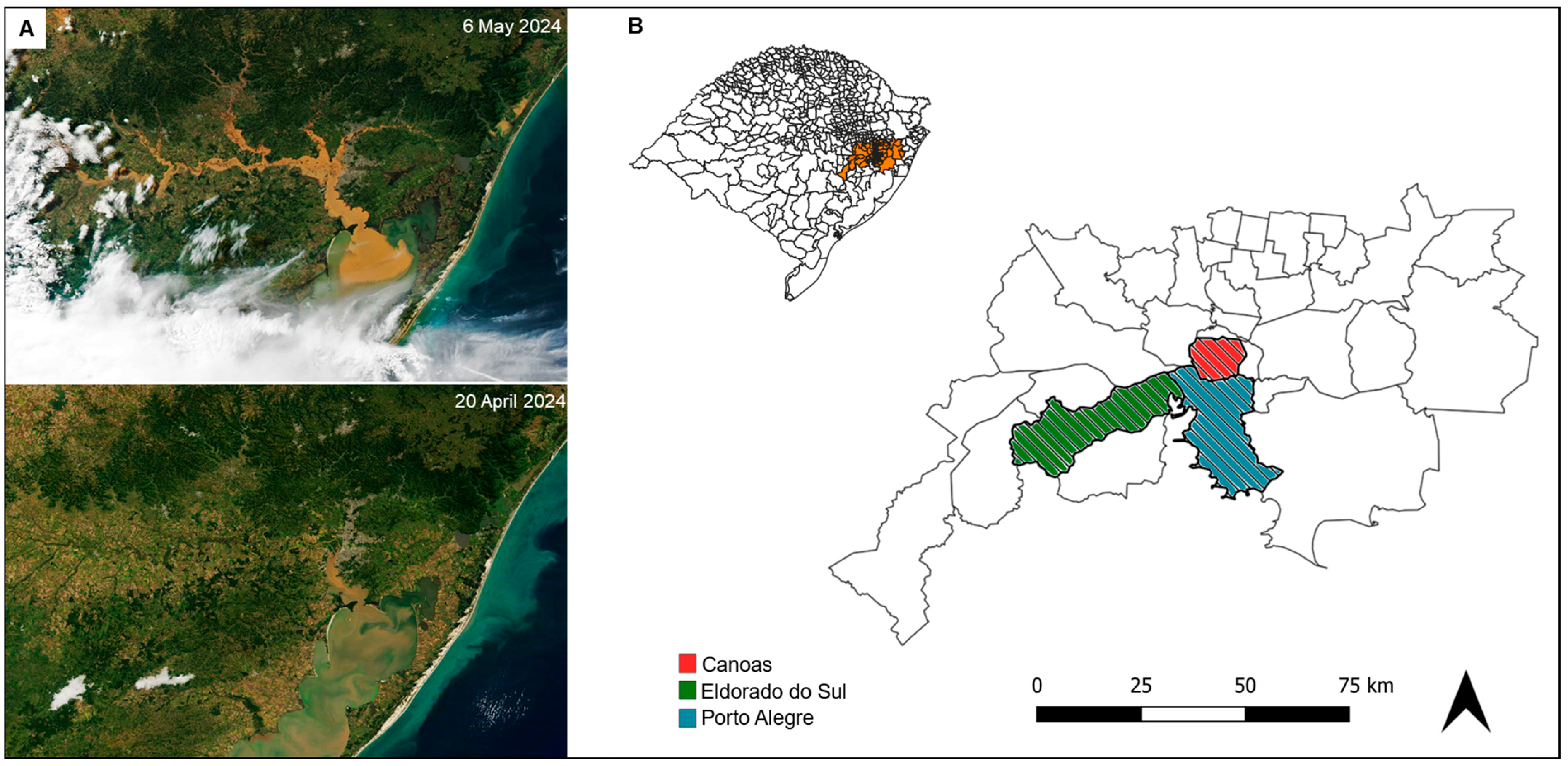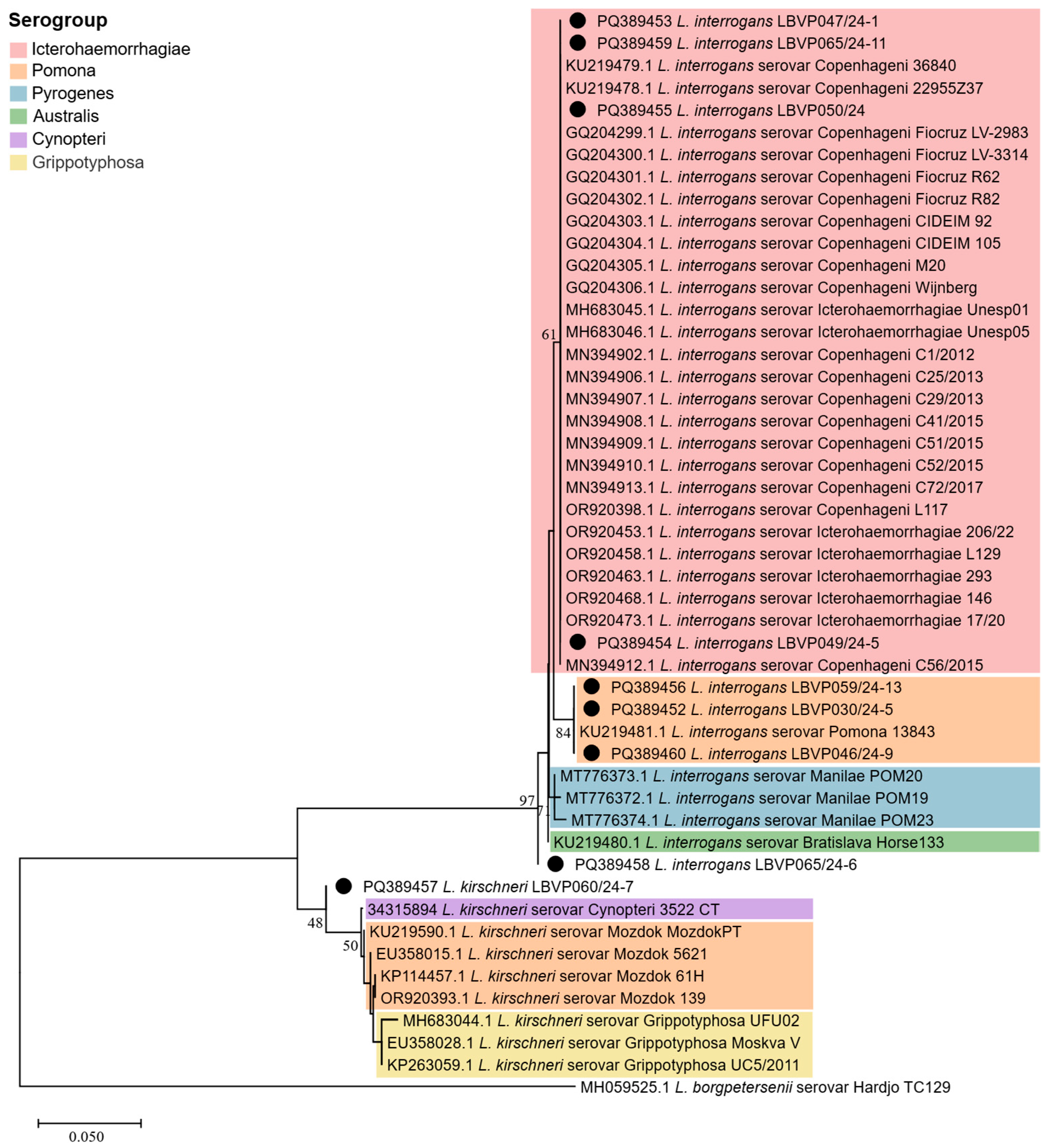Canine Leptospirosis in Flood-Affected Areas of Southern Brazil: Molecular Assessment and Public Health Implications
Abstract
1. Introduction
2. Material and Methods
2.1. Animals and Sample Collection
2.2. In Vitro Specificity of Leptospira spp. Detection in Blood and Urine Samples
2.3. qPCR Validation and Detection of Leptospira spp. in Canine Clinical Samples
2.4. Leptospira spp. Differentiation Based on Partial secY Sequencing
3. Results
3.1. Validation of Pooled Samples for Molecular Diagnosis of Leptospirosis
3.2. Occurrence of Leptospira spp. in Dogs Rescued from the Floods in Porto Alegre and Metropolitan Region
3.3. Leptospira spp. Differentiation Based on secY Phylogenetic Analysis
4. Discussion
5. Conclusions
Supplementary Materials
Author Contributions
Funding
Institutional Review Board Statement
Informed Consent Statement
Data Availability Statement
Acknowledgments
Conflicts of Interest
References
- Naing, C.; Reid, S.A.; Aye, S.N.; Htet, N.H.; Ambu, S. Risk factors for human leptospirosis following flooding: A meta-analysis of observational studies. PLoS ONE 2019, 14, e0217643. [Google Scholar] [CrossRef] [PubMed]
- Chadsuthi, S.; Chalvet-Monfray, K.; Wiratsudakul, A.; Modchang, C. The effects of flooding and weather conditions on leptospirosis transmission in Thailand. Sci. Rep. 2021, 11, 1486. [Google Scholar] [CrossRef] [PubMed]
- Mohhadam, S.V.; Vadde, K.K.; Phan, D.C.; Jafarzadeh, A.; Kapoor, V. Assessing the impact of flooding on bacterial community structure and occurrence of potentially pathogenic bacteria in Texas Rivers after Hurricane Harvey. J. Hazard. Mater. Lett. 2022, 3, 100058. [Google Scholar] [CrossRef]
- Samrot, A.V.; Sean, T.C.; Bhavya, K.S.; Sahithya, C.S.; Chan-Drasekaran, S.; Palanisamy, R.; Robinson, E.R.; Subbiah, S.K.; Mok, P.L. Leptospiral Infection, Pathogenesis and Its Diagnosis—A Review. Pathogens 2021, 10, 145. [Google Scholar] [CrossRef] [PubMed]
- Bierque, E.; Thibeaux, R.; Girault, D.; Soupé-Gilbert, M.; Goarant, C. A systematic review of Leptospira in water and soil environments. PLoS ONE 2020, 15, e0227055. [Google Scholar] [CrossRef] [PubMed]
- Reagan, K.L.; Sykes, J.E. Diagnosis of canine leptospirosis. Vet. Clin. N. Am. Small Anim. Pract. 2019, 49, 719–731. [Google Scholar] [CrossRef] [PubMed]
- Defesa Civil RS. Defesa Civil Atualiza Balanço Das Enchentes No RS—08/7; Casa Militar and Defesa Civil RS: Porto Alegre, Brazil, 2024.
- Centro Estadual de Vigilância RS. Informe de agravos das enchentes 15/08/2024; Secretaria Estadual de Saúde—RS: Porto Alegre, Brazil, 2024.
- Cummings, C. International Space station images of flooding in Rio Grande Do Sul, Brazil: May 6, 2024. In International Space Station Program, NASA Johnson Space Center Earth Science and Remote Sensing Unit, ARES Division, Exploration Architecture, Integration & Science Directorate; 2024. Available online: https://earthobservatory.nasa.gov/images/152795/floods-engulf-porto-alegre (accessed on 31 March 2025).
- QGIS.org QGIS Geographic Information System. 2024. Available online: https://qgis.org/resources/hub/ (accessed on 22 August 2024).
- Ahmed, N.; Devi, S.M.; de los Á Valverde, M.; Vijayachari, P.; Machang’u, R.S.; Ellis, W.A.; Hartskeerl, R.A. Multilocus sequence typing method for identification and genotypic classification of pathogenic Leptospira species. Ann. Clin. Microbiol. Antimicrob. 2006, 5, 28. [Google Scholar] [CrossRef][Green Version]
- Di Azevedo, M.I.N.; Pires, B.C.; Barbosa, L.F.C.; Carvalho-Costa, F.A.; Lilenbaum, W. Characterization of leptospiral DNA in the follicular fluid of non-pregnant cows. Vet. Rec. 2021, 188, e143. [Google Scholar] [CrossRef] [PubMed]
- Geneious Biologics. 2024. Available online: https://www.geneious.com/ (accessed on 26 September 2024).
- Kurilung, A.; Keeratipusana, C.; Suriyaphol, P.; Hampson, D.J.; Prapasarakul, N. Genomic analysis of Leptospira interrogans serovar Paidjan and Dadas isolates from carrier dogs and comparative genomic analysis to detect genes under positive selection. BMC Genom. 2019, 20, 168. [Google Scholar] [CrossRef]
- Philip, N.; Affendy, N.B.; Masri, S.N.; Yuhana, M.Y.; Than, L.T.L.; Sekawi, Z.; Neela, V.K. Combined PCR and MAT improves the early diagnosis of the biphasic illness leptospirosis. PLoS ONE 2020, 15, e0239069. [Google Scholar] [CrossRef] [PubMed]
- Miotto, B.A.; Guilloux, A.G.A.; Tozzi, B.F.; Moreno, L.Z.; da Hora, A.S.; Dias, R.A.; Heinemann, M.B.; Moreno, A.M.; de Souza Filho, A.F.; Lilenbaum, W.; et al. Prospective study of canine leptospirosis in shelter and stray dog populations: Identification of chronic carriers and different leptospira species infecting dogs. PLoS ONE 2018, 13, e0200384. [Google Scholar] [CrossRef] [PubMed]
- Costa, A.C.T.R.B.; Colocho, R.A.B.; Pereira, C.R.; Lage, A.P.; Heinemann, M.B.; Dorneles, E.M.S. Canine leptospirosis in stray and sheltered dogs: A systematic review. Anim. Health Res. Rev. 2022, 23, 39–58. [Google Scholar] [CrossRef] [PubMed]
- Oliveira, S.T.; Messick, J.B.; Biondo, A.W.; dos Santos, A.P.; Stedile, R.; Dalmolin, M.L.; Guimarães, A.M.d.S.; Mohamed, A.S.; Riediger, I.N.; González, F.H.D. Exposure to Leptospira spp. in sick dogs, shelter dogs and dogs from an endemic area: Points to consider. Acta Sci. Vet. 2012, 40, 1056. [Google Scholar]
- Sykes, J.E.; Francey, T.; Schuller, S.; Stoddard, R.A.; Cowgill, L.D.; Moore, G.E. Updated ACVIM consensus statement on leptospirosis in dogs. J. Vet. Intern. Med. 2023, 37, 1966–1982. [Google Scholar] [CrossRef] [PubMed]
- Borges, A.L.D.S.B.; Aymée, L.; Carvalho-Costa, F.A.; Lilenbaum, W.; Di Azevedo, M.I.N. Molecular epidemiology of Leptospira spp. serogroup Sejroe associated with chronic bovine leptospirosis. Vet. Microbiol. 2024, 298, 110238. [Google Scholar] [CrossRef]
- Dos Santos Pereira, P.V.; Di Azevedo, M.I.N.; Dos Santos Baptista Borges, A.L.; Loureiro, A.P.; Martins, G.; Carvalho-Costa, F.A.; Souza-Fabjan, J.M.G.; Lilenbaum, W. Bovine genital leptospirosis: Evidence of ovarian infection by Leptospira interrogans. Vet. Microbiol. 2022, 271, 109489. [Google Scholar] [CrossRef] [PubMed]


| Animal ID | Breed | Lifecycle Stage | Gender | Rescue Location (City) | Clinical Signs | Treatment | Molecular Analysis | ||||
|---|---|---|---|---|---|---|---|---|---|---|---|
| Status | Description | Any Antibiotic Therapy? * | Antimicrobial Drug (days) | Sample Type | CT | Leptospiral Identification ** | |||||
| 030/24-5 | Mixed breed | Senior | Female | Eldorado do Sul | Suspected | Lethargy/Jaundice | Yes | doxycycline (3) | Blood | 35.69 | L. interrogans |
| 046/24-9 | Mixed breed | unknown | Male | Canoas | Asymptomatic | No | Blood | 34.67 | L. interrogans | ||
| 047/24-1 | American Pit Bull Terrier | Puppy | Male | Porto Alegre | Asymptomatic | Yes | doxycycline (12) | Urine | 25.89 | L. interrogans | |
| 049/24-5 | Mixed breed | unknown | Female | Porto Alegre | Asymptomatic | No | Pool | 33.31 | L. interrogans | ||
| 050/24 | Mixed breed | Adult | Male | Porto Alegre | Suspected | Jaundice | Yes | doxycycline (3) | Urine | 32.48 | L. interrogans |
| 059/24-13 | Mixed breed | Adult | Male | Porto Alegre | Asymptomatic | unknown | Pool | 18.33 | L. interrogans | ||
| 060/24-7 | Mixed breed | Adult | Male | unknown | Asymptomatic | Yes | enrofloxacin (3) | Urine | 27.08 | L. kirschneri | |
| 065/24-6 | Mixed breed | Adult | Male | unknown | Asymptomatic | No | Urine | 35.80 | L. interrogans | ||
| 065/24-11 | Mixed breed | Adult | Male | Porto Alegre | Asymptomatic | No | Urine | 38.66 | L. interrogans | ||
Disclaimer/Publisher’s Note: The statements, opinions and data contained in all publications are solely those of the individual author(s) and contributor(s) and not of MDPI and/or the editor(s). MDPI and/or the editor(s) disclaim responsibility for any injury to people or property resulting from any ideas, methods, instructions or products referred to in the content. |
© 2025 by the authors. Licensee MDPI, Basel, Switzerland. This article is an open access article distributed under the terms and conditions of the Creative Commons Attribution (CC BY) license (https://creativecommons.org/licenses/by/4.0/).
Share and Cite
Merker Breyer, G.; Noronha Arechavaleta, N.; Corrêa da Silva, B.; Rocha Jacques da Silva, M.E.; Costa Torres, M.; Cadó Nemitz, L.; da Rosa Marques, R.; Borges Meurer, F.; Linden, G.A.; Soares Weyh, T.; et al. Canine Leptospirosis in Flood-Affected Areas of Southern Brazil: Molecular Assessment and Public Health Implications. Infect. Dis. Rep. 2025, 17, 63. https://doi.org/10.3390/idr17030063
Merker Breyer G, Noronha Arechavaleta N, Corrêa da Silva B, Rocha Jacques da Silva ME, Costa Torres M, Cadó Nemitz L, da Rosa Marques R, Borges Meurer F, Linden GA, Soares Weyh T, et al. Canine Leptospirosis in Flood-Affected Areas of Southern Brazil: Molecular Assessment and Public Health Implications. Infectious Disease Reports. 2025; 17(3):63. https://doi.org/10.3390/idr17030063
Chicago/Turabian StyleMerker Breyer, Gabriela, Nathasha Noronha Arechavaleta, Bruna Corrêa da Silva, Maria Eduarda Rocha Jacques da Silva, Mariana Costa Torres, Laura Cadó Nemitz, Rafaela da Rosa Marques, Fernando Borges Meurer, Gabriela Amanda Linden, Tainara Soares Weyh, and et al. 2025. "Canine Leptospirosis in Flood-Affected Areas of Southern Brazil: Molecular Assessment and Public Health Implications" Infectious Disease Reports 17, no. 3: 63. https://doi.org/10.3390/idr17030063
APA StyleMerker Breyer, G., Noronha Arechavaleta, N., Corrêa da Silva, B., Rocha Jacques da Silva, M. E., Costa Torres, M., Cadó Nemitz, L., da Rosa Marques, R., Borges Meurer, F., Linden, G. A., Soares Weyh, T., & Maboni Siqueira, F. (2025). Canine Leptospirosis in Flood-Affected Areas of Southern Brazil: Molecular Assessment and Public Health Implications. Infectious Disease Reports, 17(3), 63. https://doi.org/10.3390/idr17030063







